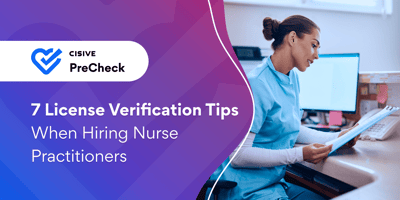

If your organization hires nurses, you already know the stakes: One overlooked license issue or...

The U.S. is on track to face a shortfall of more than 78,000 full-time nurses by 2025, according to the American Association of Colleges of Nursing (AACN). And the U.S. Chamber of Commerce estimates that some states will experience shortages exceeding 20% by 2037. While retirements and burnout drive many nurses out of the profession, the pipeline isn’t filling fast enough to keep up. In 2023, the AACN found that U.S. nursing schools turned away over 65,000 qualified candidates due to limited faculty, clinical placements, and budget constraints. For hospitals, that means fewer candidates to hire—and more pressure to secure talent earlier in the journey.
The nursing shortage continues to be a present-day challenge with wide-ranging impacts: increased patient loads, higher turnover, and longer wait times for care. Short-term fixes like travel staffing can help ease the strain, but they don’t solve the core issue: a limited, overextended talent pipeline that starts upstream in nursing education.
To build a workforce that’s ready for what’s next, healthcare employers need a proactive recruiting strategy that connects nursing students with job openings early, supports them through training, and makes it easy for them to stay. You don’t fix your lineup by ignoring the bench. The first step in building your winning talent pipeline starts with determining how to recruit nursing students through institutional partnerships, stronger incentives, career mapping, and winning hiring and onboarding systems.

You can’t recruit top nursing talent effectively without first understanding what’s pushing them off the field. The core issue isn’t a lack of interest; it’s a lack of access. The AACN found that in 2023-2024, 66,000 qualified nurses were turned away from nursing programs due to a lack of faculty, clinical sites, and funding. And the 2022 National Sample Survey of Registered Nurses projects that 23% of RNs working in outpatient, ambulatory, and clinical settings plan to retire over the next 5 years. This workforce shift will leave a gap between supply and demand that will only grow wider.
Rural and nonmetropolitan hospitals are projected to see shortages of 13% or more by 2025 according to the U.S. Chamber of Commerce. Some states, like Washington and North Carolina, face even steeper deficits as soon as 2037. Without a way to bring more students through the pipeline, the game plan falls apart.
Every great team starts with smart recruiting. For healthcare organizations, that means partnering directly with nursing schools to create long-term, built-in talent pipelines. Some hospitals are even buying nursing schools to get a direct talent pipeline. Academic-clinical partnerships allow students to train in hospital settings and become familiar with your team and culture before they graduate—a powerful advantage in today’s competitive landscape.
Some health systems are getting even more strategic. From offering on-site simulation labs to co-funding faculty salaries and preceptor stipends, forward-looking hospitals are finding creative ways to expand student capacity and gain earlier access to promising talent. Others are sponsoring students’ education in exchange for a commitment to work at the hospital post-graduation. Programs like these allow health systems to build loyalty and tacit organizational knowledge while planning for long-term staffing needs.
Today’s nursing professionals are looking for more than a paycheck. They want mentorship, work-life balance, and clear growth paths. Medical institutions that stand out offer packages that go beyond the basics. Consider offering desirable incentives such as:
These perks may seem small, but they send a big message: we’re investing in your career, not just filling a shift. In a labor market where skilled nurses have options, that kind of commitment goes a long way.
Nurse recruitment is only half the battle. Once students graduate, onboarding can make or break their experience—and their decision to stay. Nearly 30% of new nurses consider leaving the profession within the first year, often due to poor support or unclear expectations.
A strong onboarding playbook should cover everything from credentialing and license verification to EHR training, clinical workflows, and team integration. Tools like Cisive PreCheck’s StudentCheck, credentialing solutions and license monitoring help automate compliance and reduce day-one friction—so nurses can spend more time focusing on exceptional patient care and less time chasing paperwork.
In today’s hiring environment, speed matters. A slow background check or manual credentialing process can cost you a great candidate, especially when other employers are moving faster. By integrating background screening, ongoing monitoring, and license verification into your hiring workflows, you can shrink time-to-hire without sacrificing compliance.
Think of it as cutting days off your nurse recruiting clock. With PreCheck’s healthcare-first tools, hospitals can get new nurses through screening, onboarding, and credentialing faster—and with fewer red flags slipping through the cracks.
In a tight labor market, that edge could be the difference between winning your top pick and starting a shift short-handed.
The nursing shortage won’t fix itself, but with creative nurse recruitment strategy, hospitals don’t have to wait for change to come from outside. By teaming up with nursing schools, offering meaningful incentives, and investing in smarter onboarding, healthcare industry leaders can shape their own future talent pipeline.
If you’re looking for how to recruit nursing talent effectively, start by meeting them where they are—in classrooms, in clinicals, and at the start of their careers. The best nurse recruitment process doesn’t begin after graduation. It starts years earlier, when hospitals show up as trusted partners in a student’s journey.
Now’s the time to draft your future lineup. Talk to a pro today about how PreCheck’s healthcare compliance solutions can help you recruit smarter, onboard faster, and stay ahead of regulatory red flags.
Author: Christine Kowalewski
Bio: Student Healthcare Screening Expert at Cisive.
Let's Connect on LinkedIn
If your organization hires nurses, you already know the stakes: One overlooked license issue or...
.jpg?height=200&name=BLOG_%20Nursing%20Background%20Check%20Requirements_%20What%20You%20Need%20to%20Know%20(Refreshed).jpg)
Ensuring quality patient care requires you to maintain knowledge of and compliance with your...

Many healthcare organizations still treat nurse practitioner license verification as a routine...